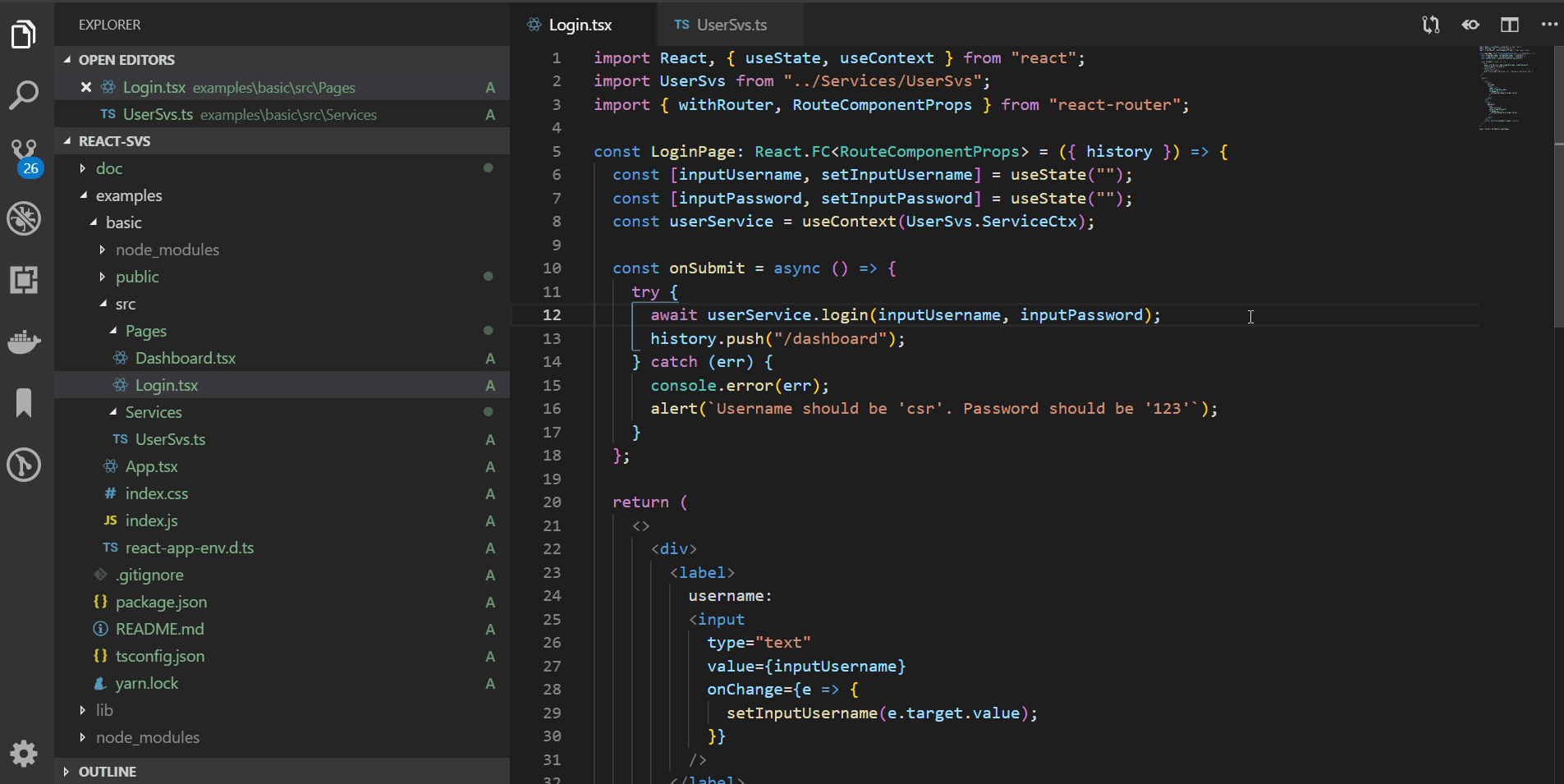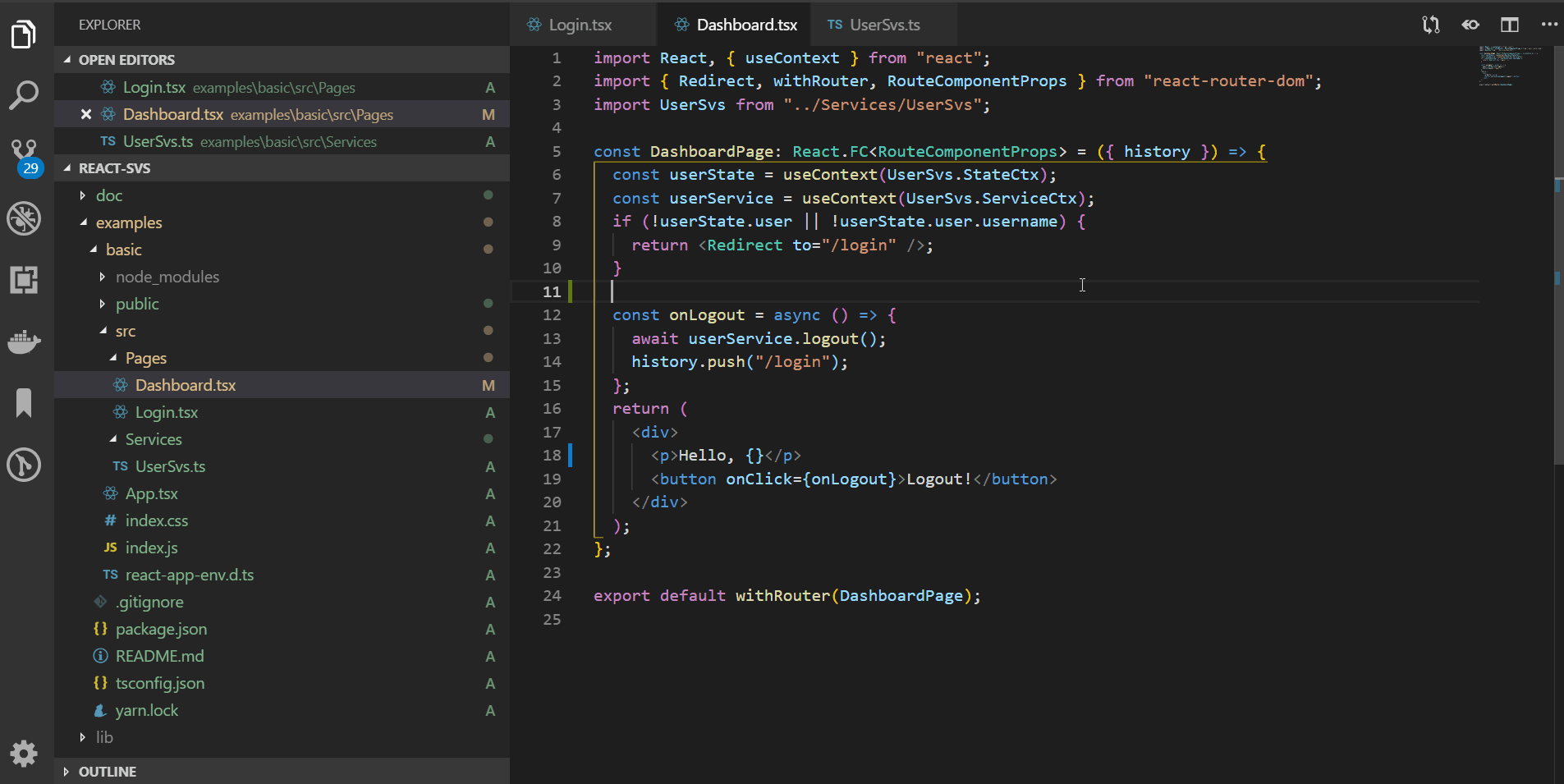README
react-svs
Homepages of this package: github and npm.
react-svs is a light-weight, type-safe state management tool for React. It is designed to achieve three goals:
- Share state within a subtree of React components.
- Update the shared state with predefined routines. Every React components within the subtree can call the update routines.
- Fully utilize Typescript. When you are accessing the shared state, or calling the update routines, react-svs will infer all the type info for you, so you can benefit from all the Typescript magic like intelliSense, type-checking and jump-to-definition.
The type inference is achieved mostly with these Typescript feature: mapped types, type inference in conditional types.
Demonstration
If you use react-svs and Typescript, you can call state-updating routines in a type-safe manner. You can benefit from all the Typescript magic like intelliSense, type-checking and jump-to-definition:

 You can refactor state-related code more easily and safely:
You can refactor state-related code more easily and safely:
 You can obtain data from shared state without worrying about typo in property names:
You can obtain data from shared state without worrying about typo in property names:

Motivation
- Most React App need to share state between components. Passing state through props(Prop Drilling) dosen't scale well.
 React 16.3.0 introduce new a Context API that allow a component to 'broadcast' data to it's component subtree.
React 16.3.0 introduce new a Context API that allow a component to 'broadcast' data to it's component subtree.react-svs is implemented with React Context API. That's why every shared state is scoped within a React component subtree.
- Redux introduces many constraints and complexity into a project. This is a trade-off to make code behaviour clear in large projects. But for middle-size and fast-iterate projects, this may be unnecessary. Read You Might Not Need Redux.
- Most state management tools don't utilize type info. The binding between update call and update implementation is determined during runtime. For example, when you emit the update call:
store.dispatch({ type: 'INCREMENT' }), although you can easily know it will execute theINCREMENTpart of the reducer(update implementation), IDE(typescript language server) can't learn about this without actually executing the code, because the update call and the update implementation is connected by a string(runtime value). So Typescript can't provide you with code completion and type-checking for the payload ofINCREMENTaction.
Concepts
react-svs is implemented with React Context API. That's why every shared state is scoped within a React component subtree.
State provider
A provider is a Component that:
- Holds the shared state. It allow its descendants to subscribe it's state.
The state object is provided by React Context API.
- Provides a service(which is an object having convenient/reusable routines)
for its descendants to update it's state.
The service object is also provided by React Context API. (But with different context)
State service
A service is an Object that:
- Can call the Provider's
setState()to update it's state. - Defines a group of convenient/reusable routines to make async request, process data, and finally update its Provider's state.
Provider and Service are one-to-one: One Provider component instance provides one Service instance.
How to use
Generally, to use react-svs, you need to:
npm install --save react-svsPrepare a service and provider. Like this:
// UserSvs.ts import { ServiceBase, ServiceMixin } from "react-svs"; async function fakeLogin(username: string, password: string) { // wait for 2s, simulating a network request await new Promise((res, rej) => { setTimeout(() => { res(); }, 100); }); if (username === "csr" && password === "123") { return { success: true, userId: 1 }; } else { return { success: false }; } } interface IUserState { user: { userId: number; username: string } | null; } const UserSvs = ServiceMixin( class extends ServiceBase({ user: null } as IUserState) { public async login(username: string, password: string) { const { success, userId } = await fakeLogin(username, password); if (!success || !userId) throw new Error("login fail"); this.setProviderState({ user: { username, userId } }); } public async logout() { // wait for 2s, simulating a network request await new Promise((res, rej) => { setTimeout(() => { res(); }, 100); }); this.setProviderState({ user: null }); } } ); export default UserSvs;Notice two things:
You define a class for service, which contains state-updating routines. react-svs will instantiate this class when a provider component is created, and bind these two objects.
Call
ServiceMixin(ServiceClass).
Host the service. Put the
Providercomponent generated byServiceMixin(ServiceClass)somewhere in the react component tree. For example, if you want to share the state within the whole app, you can put theProviderin the rootAppcomponent:// App.tsx import React from "react"; import { BrowserRouter as Router, Route, Switch } from "react-router-dom"; import UserSvs from "./Services/UserSvs"; import LoginPage from "./Pages/Login"; import DashboardPage from "./Pages/Dashboard"; function App() { return ( <Router> {/* provide the user state and user service to this subtree */} <UserSvs.Provider> <div className="App"> <Switch> <Route path="/login" component={LoginPage} /> <Route path="/dashboard" component={DashboardPage} /> <Route component={LoginPage} /> </Switch> </div> </UserSvs.Provider> </Router> ); } export default App;Obtain/update the state in any component under the
Provider. You useServiceCtxandStateCtxgenerated byServiceMixin(ServiceClass)to get service object and state object.// Dashboard.tsx import React, { useContext } from "react"; import { Redirect, withRouter, RouteComponentProps } from "react-router-dom"; import UserSvs from "../Services/UserSvs"; const DashboardPage: React.FC<RouteComponentProps> = ({ history }) => { const userState = useContext(UserSvs.StateCtx); const userService = useContext(UserSvs.ServiceCtx); if (!userState.user || !userState.user.username) { return <Redirect to="/login" />; } const onLogout = async () => { await userService.logout(); history.push("/login"); }; return ( <div> <p>Hello, {userState.user.username}</p> <button onClick={onLogout}>Logout!</button> </div> ); }; export default withRouter(DashboardPage);
There is a complete working example inside examples/basic.
API
ServiceBase
ServiceBase is used to create a base class that your service class should extends.
ServiceBase has shape like this:
type ServiceBase = (
initialState: State,
subscribeTo: SubscribeTo = {} as ISubscribeTo,
defaultProviderProps: ProviderPropsType = {} as ProviderPropsType
) => IServiceConstructor;
initialState
This parameter is used to init the Provider component's state. Also, this parameter decides the type of state. react-svs will use this type info to infer the type of many value.
When defining the service class, you can use this.providerState to get the current state of Provider and you can use this.setProviderState to update the state. The usage of this.setProviderState is same as setState of normal React component.
subscribeTo
A Provider can subscribe other React context! As many as you want! Just pass those contexts within this parameter. ISubscribeTo has shape like this:
interface ISubscribeTo {
readonly [key: string]: React.Context<any>;
}
When defining the service class, you can use this.subscribedData to get the context data you subscribe.
defaultProviderProps
Like any other normal React component, a Provider can communicate with it's parent through props. When defining the service class, you can use this.providerProps to get the props that the Provider component received.
This parameter define the default props of Provider if its parent didn't pass props to it. Also, this parameter decides the type of Provider's props. react-svs will use this type info to infer the type of many value.
ServiceMixin
ServiceMixin is used to generate Provider and React context objects from service class. Remember, the service class should extends the base class returned by ServiceBase, like the above example.
type ServiceMixin = (
ServiceConstructor: ServiceConstructor
) => ExtendedServiceConstructor;
The ExtendedServiceConstructor is a class that extends ServiceConstructor, with these additional static readonly member:
Provider. This is the Provider(a react component class). You should put this component somewhere in the react component tree, so the subtree under it can obtain/update it's state.withProvider. This is just a suger method that return a HOC to mountProvider. You can doconst MyComponentWithProvider = withProvider(MyComponent)so thatProviderwill be mounted aboveMyComponent.ServiceCtx. This is a React Context Object(created by React.createContext internally). This context provide the state service. The components that want to update the shared state shoud subscribe this.StateCtx. This is a React Context Object(created by React.createContext internally). This context provide the state. The components that want to obtain the shared state shoud subscribe this.